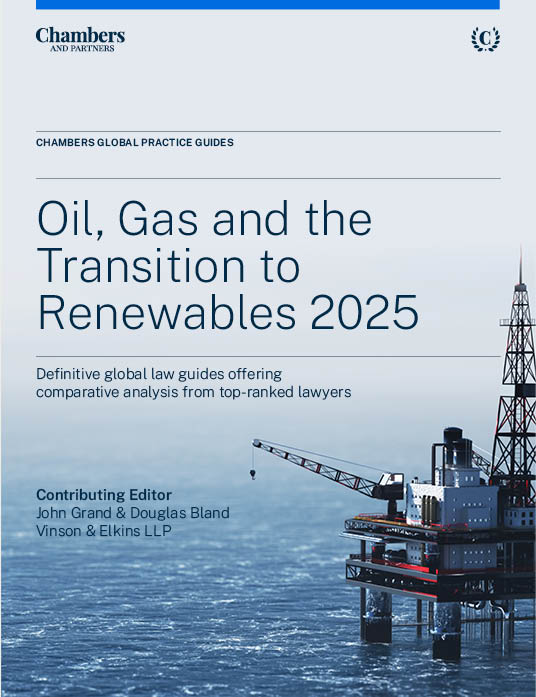
Oil, Gas and the Transition to Renewables 2025
The Oil, Gas and the Transition to Renewables 2025 guide covers a range of key jurisdictions. As the industry grapples with the energy transition, this guide provides the latest legal information on petroleum ownership; national oil or gas companies; private investment in upstream/midstream and downstream operations; foreign investment; environmental, health and safety (EHS); and liquefied natural gas (LNG) projects.
Last Updated: August 07, 2025
Compare law and practice by selecting locations and topic(s)
Select Locations

Select Topic(s)

Please select at least one location and one topic to use the compare functionality.
Overview
Global energy demand continued its upward trajectory in 2024, with all major forecasts projecting sustained growth for the foreseeable future. According to the International Energy Agency (IEA), global energy demand increased by 2.2% in 2024, outpacing the historical average of 1.3%. Both oil and natural gas consumption rose – by 0.8% and 2.7%, respectively – despite mounting international pressure to accelerate the transition to renewable energy sources.
The debate over the pace and direction of the energy transition was a central issue in the 2024 United States presidential election. Vice President Kamala Harris, following the policies of President Joe Biden, campaigned on a platform of clean energy and a managed transition away from fossil fuels. In contrast, President Donald Trump championed a policy of American energy independence, deregulation, and increased domestic production, encapsulated by the slogan “Drill Baby Drill.” The stark contrast between these positions underscored the polarised nature of the energy debate in the United States.
Following the election, sentiment within the traditional oil and gas sector improved markedly. Industry executives and investors viewed many of President Trump’s proposed policies – such as deregulation, streamlined permitting, and lower taxes – as favourable for new investment in drilling and development. However, concerns remain regarding the potential negative impact of tariff policies, which could increase costs and slow growth. The ongoing tariff disputes have already begun to affect the costs of drilling and development, though the ultimate impact on oil and gas prices remains uncertain.
Commodity prices experienced significant volatility in the first half of 2025, largely driven by global political developments. President Trump’s announcement of new tariffs in April 2025 triggered a sharp decline in oil prices, followed by a partial rebound after he paused the implementation of some major tariffs. Prices fell again in May 2025 when OPEC+ announced increased production, only to spike in June with the onset of the Israel/Iran conflict.
Prior to April 2025, oil and gas asset acquisition and divestiture (A&D) activity was steady. The wave of “mega-mergers” in late 2023 and early 2024 was followed by a period in which mid- and small-cap upstream operators sought exit opportunities amid relatively stable commodity prices.
Simultaneously, private equity and alternative capital providers renewed their interest in the sector, creating a dynamic market environment characterised by both consolidation and the entry of new participants.
Since April 2025, heightened global political uncertainty has made A&D activity more challenging, but companies and investors continue to pursue transactions. With energy demand expected to keep rising, oil and gas companies are likely to continue seeking synergistic and opportunistic acquisitions, while maintaining disciplined capital allocation and a focus on shareholder returns.
Despite the persistent growth in global oil and gas demand, energy companies are increasingly participating in the energy transition by investing in alternative energy sources.
Short-Term Trends
Commodity price uncertainty
The outlook for economic growth and commodity prices in the remainder of 2025 is highly uncertain. Geopolitical risks – including conflicts in the Middle East and Ukraine, OPEC+ production decisions, tariff disputes, US fiscal policy, inflation, and interest rates – continue to drive significant volatility in oil and gas prices. Over the past year, Brent crude prices have fluctuated between USD60 and USD85 per barrel, complicating capital budgeting and M&A planning for industry participants.
Drilling and completion costs
The introduction of President Trump’s “Liberation Day” tariffs has injected further cost uncertainty into the industry. Many key inputs for drilling and completion – such as steel, oil country tubular goods (OCTG), cement, and drilling fluids – are imported. Experts estimate that tariffs could increase drilling and completion costs by 4.5% to 10%, directly impacting capital budgets and development plans.
Supply and demand dynamics
While there is broad consensus that global energy demand will continue to rise, there is significant disagreement over the future energy mix. Energy is essential for lifting billions out of poverty and supporting basic services, as well as powering technological advancements such as data centres and artificial intelligence. The IEA projects that global oil demand will peak by 2029, with supply outpacing demand by 2030. In contrast, OPEC forecasts robust demand growth, particularly in developing countries, and warns of potential supply shortfalls and price volatility without substantial new investment.
Long-Term Trends
Social and government pressures
Concerns about the climate impact of fossil fuels have led to increased regulation and political pressure on oil and gas companies. Heightened climate awareness has also influenced investment decisions, with some investors shifting away from the sector. However, recent geopolitical events and recognition of the limitations of renewables have tempered some of this pressure, leading to a more balanced approach that acknowledges the ongoing importance of hydrocarbons.
Accelerating investment in energy transition
Significant capital is being deployed into the energy transition, including renewable power generation and carbon capture, utilisation, and storage (CCUS) technologies. The Inflation Reduction Act of 2022 was expected to accelerate clean energy investment in the USA, but its future under the Trump administration is uncertain. The scale of investment required to meaningfully reduce hydrocarbon consumption remains enormous.
Industry consolidation
Public companies continue to pursue consolidation to achieve synergies, reduce costs, and increase production without significant capital expenditure. This trend has reduced the availability of capital for new investments, which may negatively impact future oil and gas production.
Access to capital
Large, investment-grade oil and gas companies retain access to debt and equity markets, enabling them to fund acquisitions and development. Smaller companies, however, face increasing challenges in securing financing, as traditional lenders reduce their exposure. Alternative financing structures, such as asset-backed securitisations, are becoming more prevalent. Higher interest rates have further constrained capital availability and increased borrowing costs, leading to fewer new investments in exploration and production.
Global realignment
The ongoing war in Ukraine and the escalating conflict between Israel and Iran have accelerated a global realignment of energy markets, dividing the world into two primary blocs: the United States and Europe on one side, and Russia and China on the other.
For decades, European nations depended heavily on Russian energy supplies. However, Russia’s invasion of Ukraine and the subsequent imposition of sanctions have exposed the vulnerability of the global energy infrastructure. In response, European countries have urgently sought alternative sources of hydrocarbons, often paying premium prices to secure supplies from the United States and the Middle East. This shift has significantly reduced Russian exports to Europe, prompting Russia to redirect its oil and natural gas toward Asian markets, particularly China and India.
These developments have also spurred the rapid expansion of large-scale liquefied natural gas (LNG) projects in the United States, alongside the construction of new LNG import facilities across Europe. Additionally, European nations have accelerated investments in renewable energy to reduce their reliance on imported hydrocarbons. Although the Biden administration temporarily paused new LNG projects in early 2024, this restriction was subsequently lifted by the Trump administration, allowing these projects to proceed. As a result, the United States is poised to continue increasing its natural gas exports to meet growing global demand.
Political tensions and sanctions are further reshaping investment patterns in the energy sector. Heightened friction between the United States and China has led many Chinese state-owned enterprises to withdraw from American energy investments. Conversely, Western investors have rapidly divested from Russian energy assets. Before the Ukraine invasion, Russia – then the world’s second-largest oil producer – benefitted from substantial Western investment and expertise. The withdrawal of this capital and technical know-how continues to undermine the Russian energy sector, hampering its long-term growth and innovation.
Conclusion
In summary, the global oil and gas market is navigating a period of profound change, shaped by rising demand, geopolitical volatility, regulatory pressures, and the accelerating energy transition. While the sector faces significant challenges, it also presents opportunities for those able to adapt to the evolving landscape.

